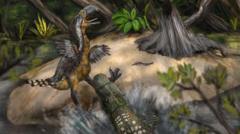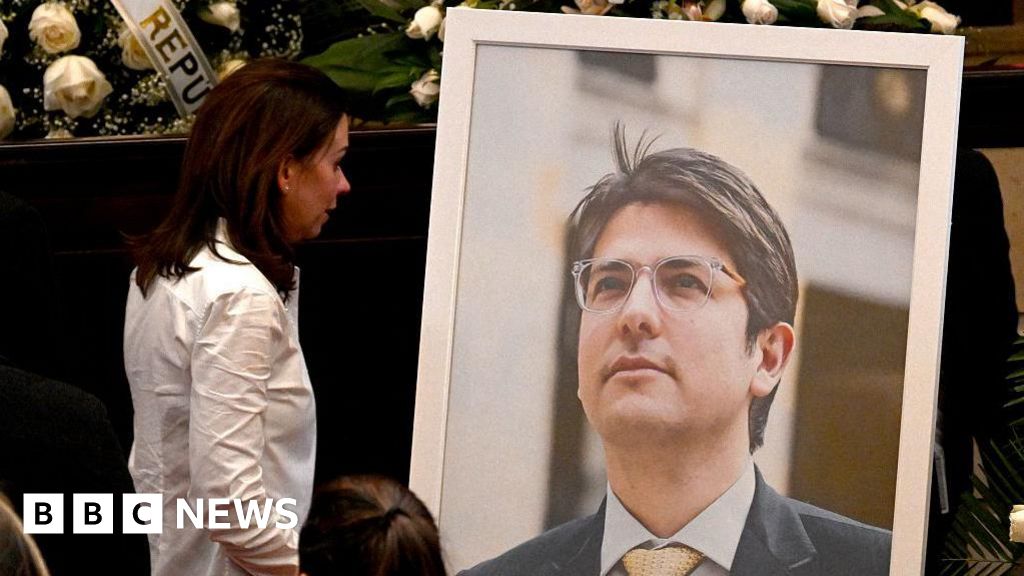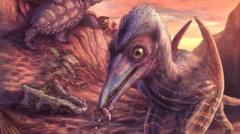The recent discovery of teeth marks on a fossilized leg bone of a terror bird, dating back 13 million years, has sparked excitement among paleontologists studying ancient predator interactions. Researchers in Colombia have concluded that this formidable avian reptile, renowned for its towering height and jagged beak, was likely slain by a larger predator, specifically an extinct caiman species. This finding enriches our understanding of the ecological dynamics during the Middle Miocene, a period marked by rich biodiversity.
Published in the journal *Biology Letters*, the study centers around meticulously analyzing teeth marks found on the leg bone of the terror bird, unearthed over 15 years ago in Colombia's Tatacoa Desert. This region, once a humid swamp, has transited through epochs, preserving the bones of ancient wildlife. The research team matched the unique characteristics of these bite marks to known specimens of crocodilian species, marking a rare case of evidence showcasing interactions between apex predators.
Lead researcher Andres Link of Universidad de Los Andes elaborated on the implications of the discovery, stating, “The absence of healing signs in the bite marks suggests that the terror bird likely died from the attack.” This pivotal evidence indicates a conflict that holds profound significance in understanding predator vulnerabilities in ancient ecosystems.
The terror bird, which stood about 2.5 meters tall with powerful legs suited for gripping and tearing its prey, faced a formidable adversary in the Purussaurus neivensis, a large crocodilian potentially growing up to five meters long. Link speculated that this ancient caiman may have ambushed its prey from the water's edge, much akin to modern crocodiles' hunting tactics.
The collaborative effort with local fossil collector César Augusto Perdomo, who unearthed the leg bone, further adds to the importance of this find.” Every piece of a body helps us understand much about life on this planet in the past,” Link expressed, emphasizing the importance of fossil records in piecing together historical ecological narratives.
As scientists continue to uncover more about ancient life through fossil studies, they remind us of the intricate and often violent relationships among prehistoric species that once roamed the Earth. This research not only enhances our understanding of biological history but also informs how ecosystems functioned millions of years ago, shedding light on the delicate balance between predator and prey.
Published in the journal *Biology Letters*, the study centers around meticulously analyzing teeth marks found on the leg bone of the terror bird, unearthed over 15 years ago in Colombia's Tatacoa Desert. This region, once a humid swamp, has transited through epochs, preserving the bones of ancient wildlife. The research team matched the unique characteristics of these bite marks to known specimens of crocodilian species, marking a rare case of evidence showcasing interactions between apex predators.
Lead researcher Andres Link of Universidad de Los Andes elaborated on the implications of the discovery, stating, “The absence of healing signs in the bite marks suggests that the terror bird likely died from the attack.” This pivotal evidence indicates a conflict that holds profound significance in understanding predator vulnerabilities in ancient ecosystems.
The terror bird, which stood about 2.5 meters tall with powerful legs suited for gripping and tearing its prey, faced a formidable adversary in the Purussaurus neivensis, a large crocodilian potentially growing up to five meters long. Link speculated that this ancient caiman may have ambushed its prey from the water's edge, much akin to modern crocodiles' hunting tactics.
The collaborative effort with local fossil collector César Augusto Perdomo, who unearthed the leg bone, further adds to the importance of this find.” Every piece of a body helps us understand much about life on this planet in the past,” Link expressed, emphasizing the importance of fossil records in piecing together historical ecological narratives.
As scientists continue to uncover more about ancient life through fossil studies, they remind us of the intricate and often violent relationships among prehistoric species that once roamed the Earth. This research not only enhances our understanding of biological history but also informs how ecosystems functioned millions of years ago, shedding light on the delicate balance between predator and prey.















